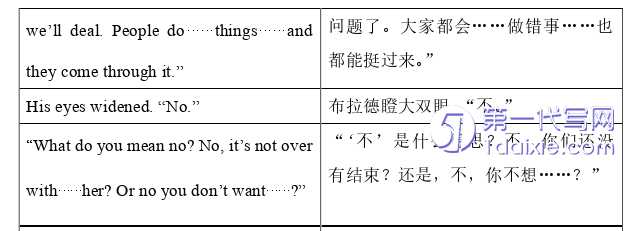本文是一篇英语毕业论文,本次英汉翻译实践的源语材料选自美国作家Sara Goodman Confino的女性主义短篇小说《她不怀好意》(She’s Up to No Good)的前八章,主要讲述女主人公在婚姻破裂后与自己脾气古怪的外祖母一同踏上返乡之旅的故事。
Chapter One Introduction
1.1 Background Information of the Translation Task
This translation project, selected by the translator due to her deep fascination with modern feminist fiction, serves as a bridge in addressing the significant language barrier that often separates Chinese and Western literary worlds. This barrier, while substantial, is not insurmountable, and the project aims to foster greater cultural understanding and exchange between these distinct literary traditions.
At the heart of this endeavor is the work of Sara Goodman Confino, an emerging American novelist whose writings are steeped in feminist themes. Confino’s unique perspective is not just shaped by her literary prowess but also by her professional experiences. As a high school teacher of English and journalism, she possesses a profound understanding of the everyday realities and challenges faced by young people. This insight is deftly woven into her narratives, lending them an authenticity and relatability that resonates deeply with readers.

1.2 Brief Introduction to the Original Works
She’s Up to No Good is Sara Goodman Confino’s second novel, in this book she mainly tells us a story between women from two different generations. After four years of marriage, Jenna breaks down when her husband asks for a divorce because of their contactless relationship and meeting a new girl as well. To take a turn for the better life, she decides to have a road trip with her eccentric grandmother Evelyn to Massachusetts, where the story of her family starts. When they get on the road, Evelyn begins to tell the story of her first love that happened almost seventy years ago. Along with the secrets and hidden story is revealed, Jenna gradually finds a different side of her grandmother. After arriving in Massachusetts, the new people and fresh environment give Jenna the brand-new perspective to see her own life and the courage and confidence to heal the pain that the suffering marriage brought to her. In this quiet town where it all started, the conversation and collision between two generations make Jenna finds the new possibility of her and of a woman’s life.
The novel has sixty-two chapters in total with more than 100,000 words, and the translator chose the first eight chapters as the source text for the translation report, which contains 11,309 words, mainly focusing on the Jenna’s confused and painful life state when she was newly divorced and the conversation with her grandmother when she first embarked on their road trip, starting the whole story.
Chapter Two Translation Process
2.1 Pre-translation
In order that the subsequent work of translation may be carried on smoothly, the translator is well prepared before the translation. First, the translator started from the author’s background, understanding the author’s work and daily life, and trying to get as close to the author as possible to see the author’s attitude to life. Eventually, these details will show up in the author’s writing. In addition to being a writer, the author also teaches English and journalism at a high school in her hometown, which shows that a strong atmosphere of life is one of the characteristics of her works, which can also be reflected in the author’s other book For the Love of Friends.
In the next place, before commencing the translation, the translator first read the whole book, and it is only when she has got a good hold of it that she began the real work of translation. The source text is a novel with a two-generation storyline, and many of the things in the story of Grandmother Evelyn are relevant to the cultural context of Jewish life in the United States in the last century. Because certain stories only happen in certain social and cultural contexts. So, in light of the lack of culture, the translator created an online understanding of 20th century Jewish life in the United States. In the early 20th century, there was a relatively high level of anti-Semitism in the United States due to economic, cultural, social, religious and other factors. Meanwhile, after the outbreak of World War II, large numbers of European Jews emigrated to the United States to seek refuge from the Holocaust.
2.2 While-translation
After the preparation of the translation was completed, the translator began the translation of the novel. Although the translator had a certain level of familiarity and overall grasp of the source text, she still encountered some difficulties and problems in the translation process.
First, fiction is different from informational texts. In the process of translation, besides transferring basic information to the reader, it is necessary to take into account linguistic style, cultural exchange and emotional transmission. In other words, how to translate a novel into a sense of story is a major difficulty in this translation project and in literary translation in general. The language style of the source language is lively and interesting, and the text is very pictorial. Therefore, translators needed to consider how to bring the same or similar reading experience to the target language readers, given different cultural backgrounds. The translator also used Reverso Context in the translation process to find out how the same English expression was translated in different contexts and used the method of only looking at the translated text without looking at the original text to continuously improve the fluency and graphic sense of the sentences.
Chapter Three Theoretical Framework ......................... 9
3.1 Introduction to the Skopos Theory ...................... 9
3.2 Three Rules of the Skopos Theory ................................ 11
3.3 Application of the Skopos Theory in the Translation ...................... 12
Chapter Four Case Analysis ........................... 14
4.1 At the Lexical Level .......................... 14
4.1.1 Recreation ................................ 14
4.1.2 Annotation ...................................... 16
Chapter Five Conclusion ............................... 34
Chapter Four Case Analysis
4.1 At the Lexical Level
In contrast to the syntactic and textual levels, equivalence at the lexical level is the easiest to achieve during translation. However, given cultural differences and differences in the pronunciation of the language itself, it is still not possible to achieve a simple and clear equivalence by literal translation in many cases, such as the translation of homophones mentioned next. Thus, guided by Skopos Theory, the translator first considered the readability of the article, then considered the background culture of the source language, and used annotations to explain unfamiliar words to the target language readers.
4.1.1 Recreation
Recreation is a translation method that would be adopted when there is a big difference between original and target texts and the original features need to be conveyed. This method gives the translators a higher freedom to recreate the target text based on their understandings and closer to the target language culture. Due to the different structure of the Chinese and English languages, and the absence of tone differences in English, English homonyms are not as abundant as those in Chinese, and most of them are words with similar sounds. Homonyms are one aspect of the humor of the novel, and therefore the translator thought it necessary to take into account the principles of coherence and fidelity, to adapt the words as nearly as possible to their original meaning, and to preserve the peculiar form of the homonyms. If this could not be done, the translator chose to focus on the rules of skopos, with a focus on readability.

Chapter Five Conclusion
This translation practice report is a reflective summary of the translator’s work on the first eight chapters of She’s Up to No Good. Integrating with the adopted guiding Skopos Theory, the report conducted an elaborate case analysis on the translated techniques and methods and the achieved effect from four aspects: lexicology, syntax, text, and rhetoric. It explored in detail how Skopos Theory guided the literary translation and how the employed translation methods and techniques addressed challenges in the translation process.
In this translation practice, the translator encountered numerous difficulties and challenges. The novel’s storyline not only unfolds in contemporary America, but also delves into life in 20th-century, focusing on the American Jewish community. As a result, translators are required to have a certain level of understanding in terms of society, culture, history, customs and more. Failure to do so could lead to confusion or bias in understanding the original text and ultimately lead to inaccurate translations that could mislead Chinese readers. Moreover, the translation of complex and lengthy sentences in the original text poses significant challenges. Issues such as how to deconstruct sentence structure and adjust sentence components were considered critically. The goal is to ensure that the translated text will conform to the expressive nuances of the Chinese language and achieve a greater level of coherence and fluency. This, in turn, is intended to enhance the overall reading experience for the audience. The challenges in this translation process highlight the importance of a deep understanding of the cultural, historical, and social contexts embedded in the source text. Overcoming these challenges requires the translator to navigate not only linguistic intricacies but also cultural nuances that contribute to a faithful and nuanced rendering of the original work in the target language.
reference(omitted)
